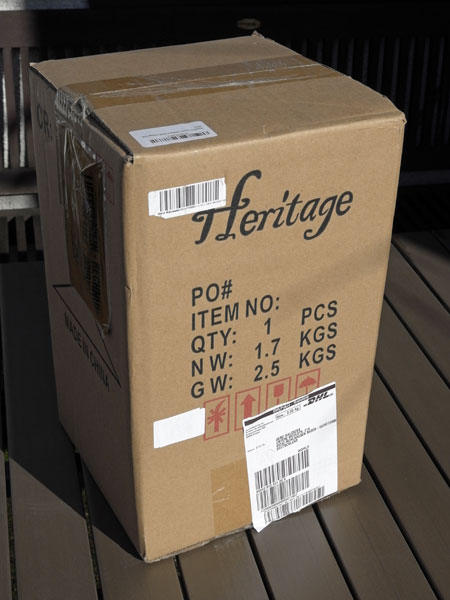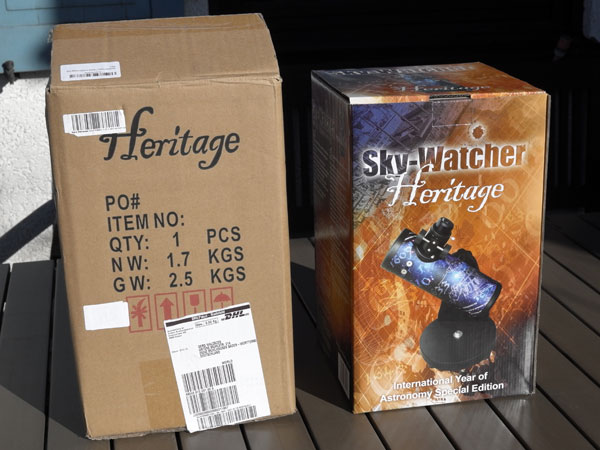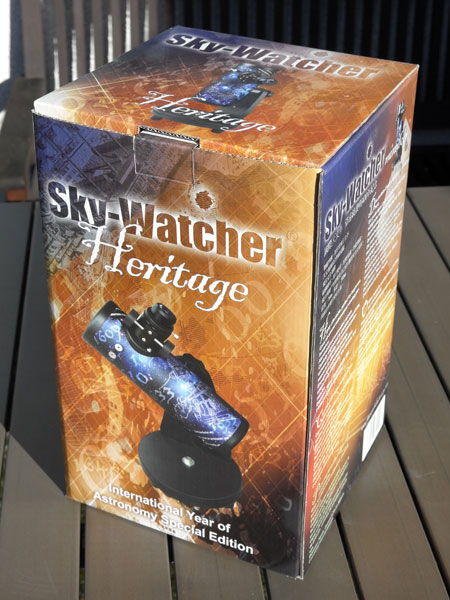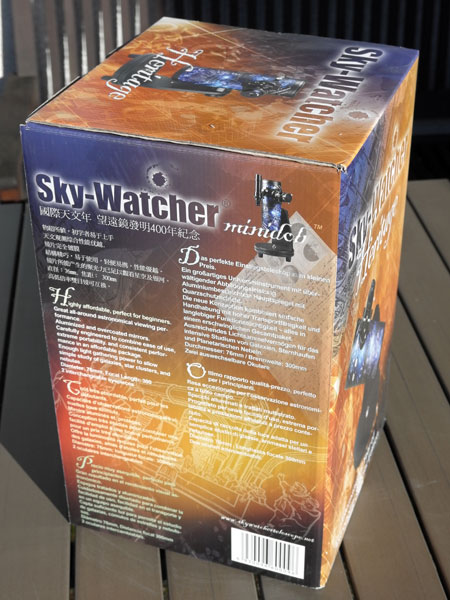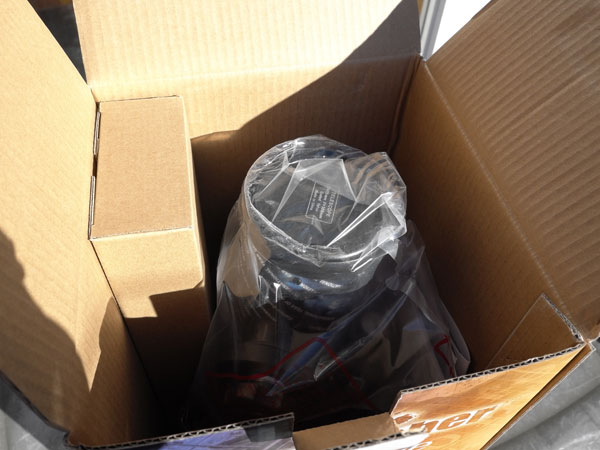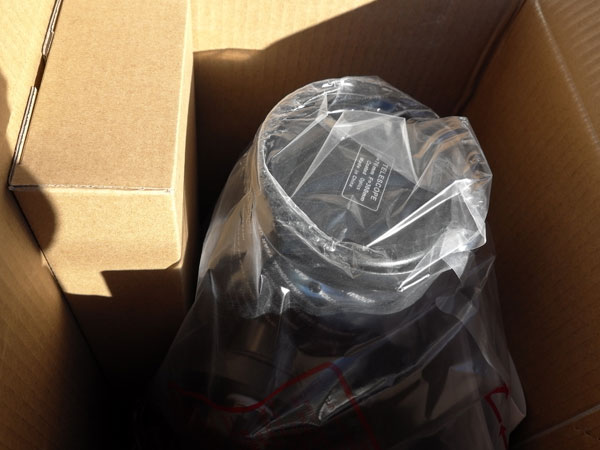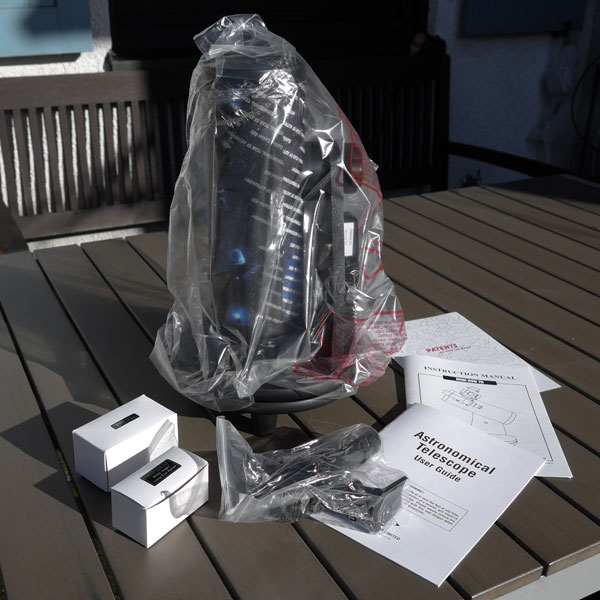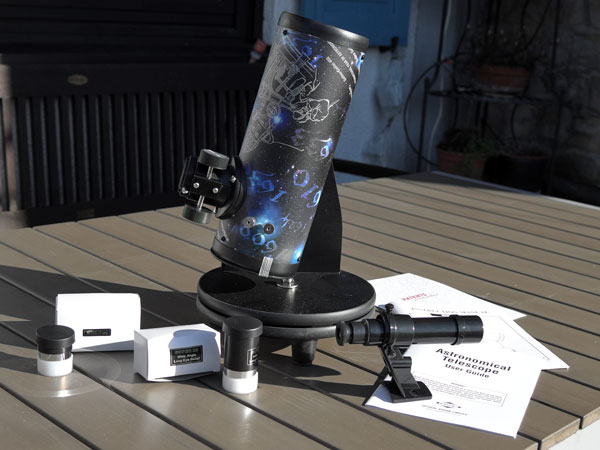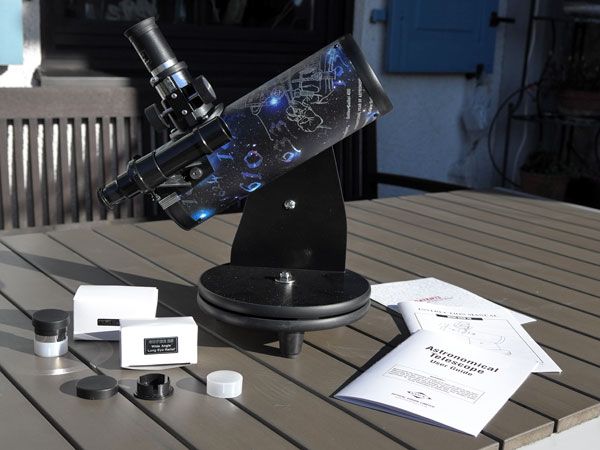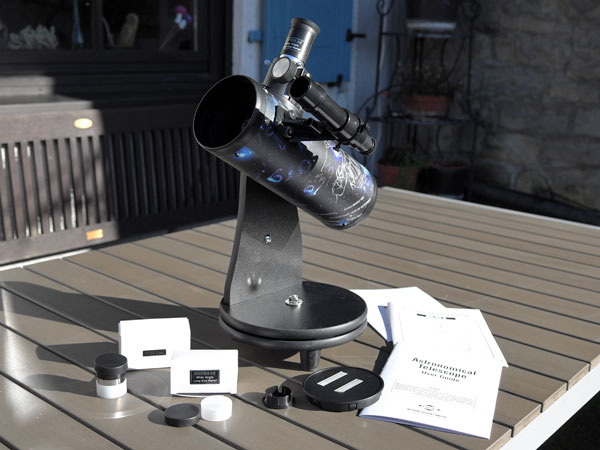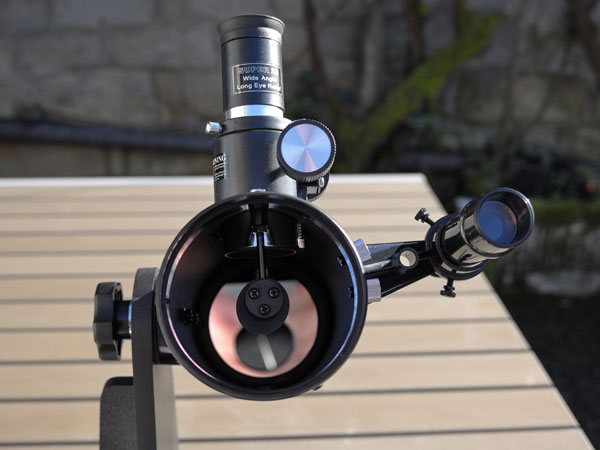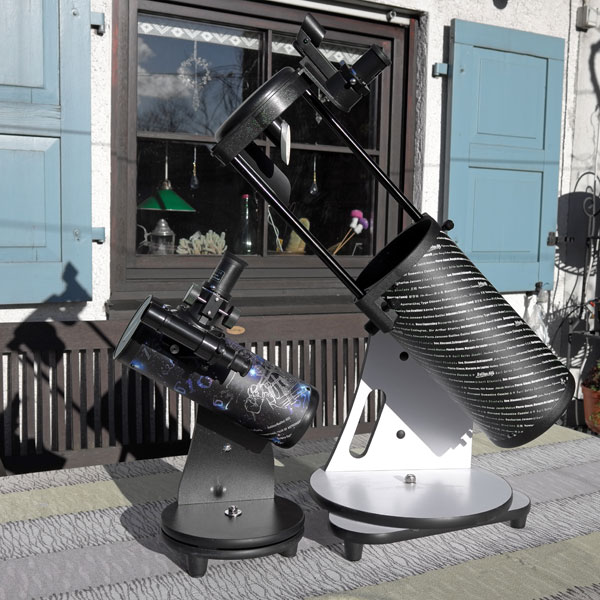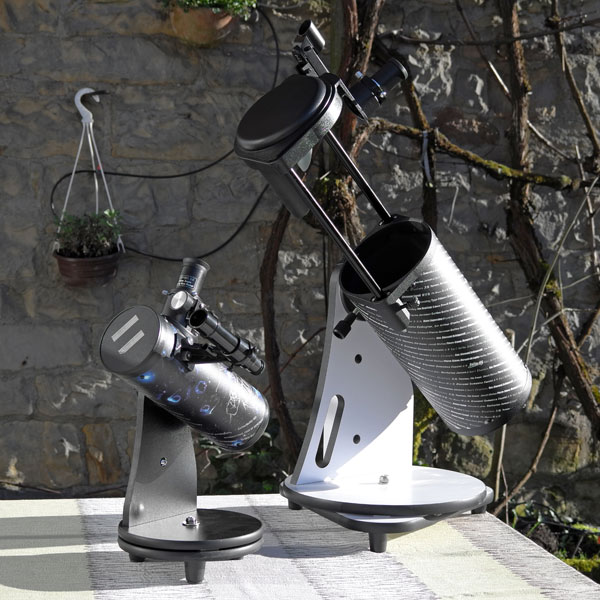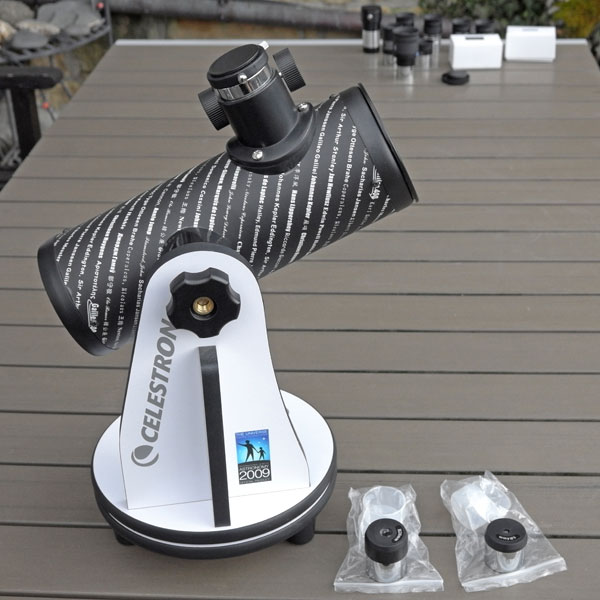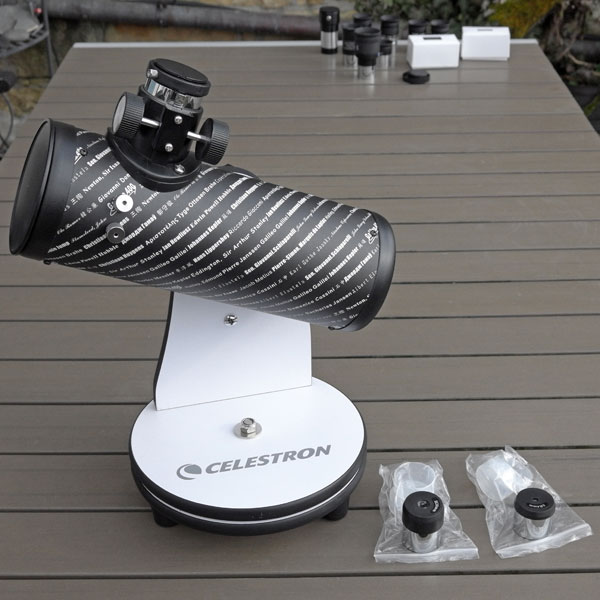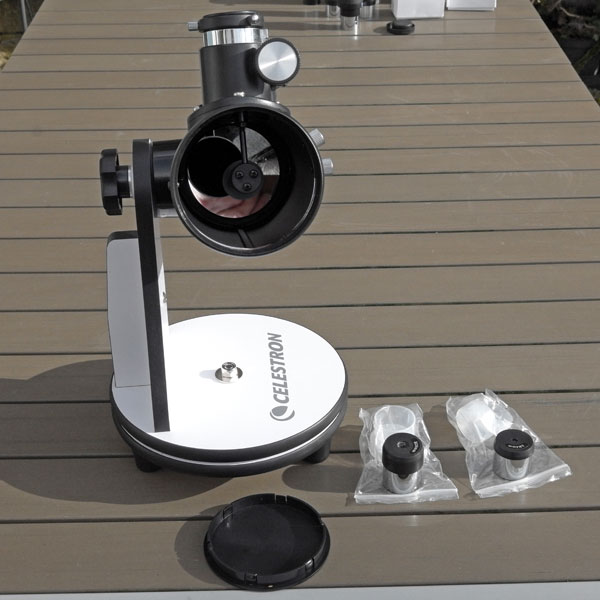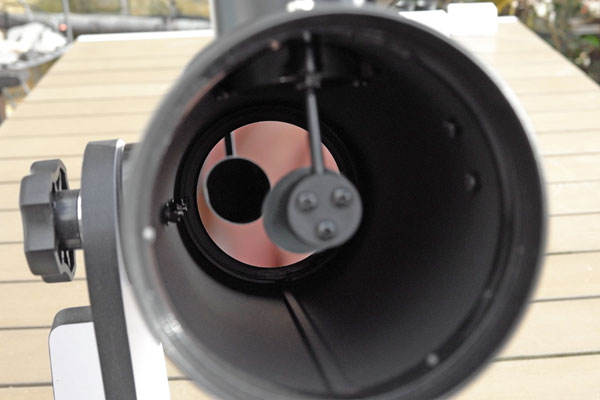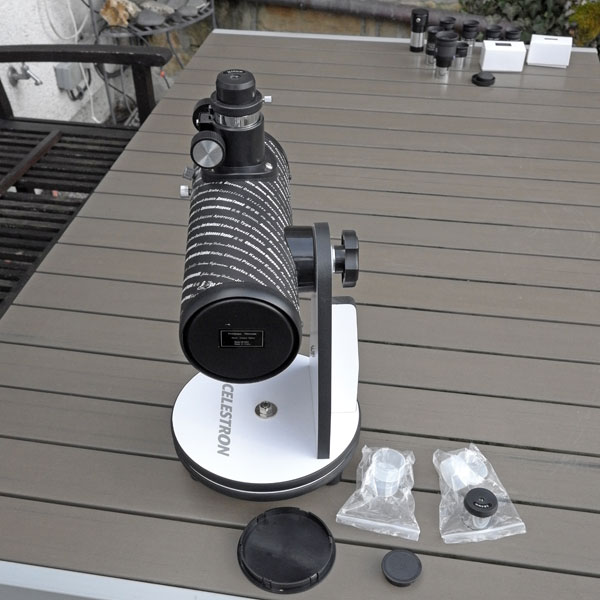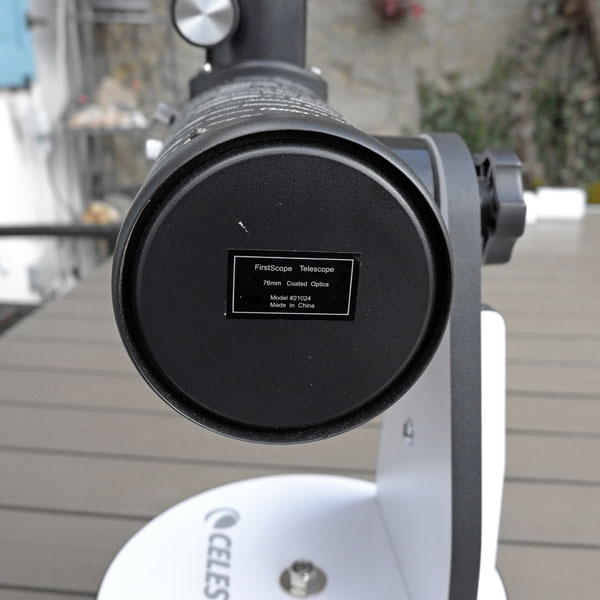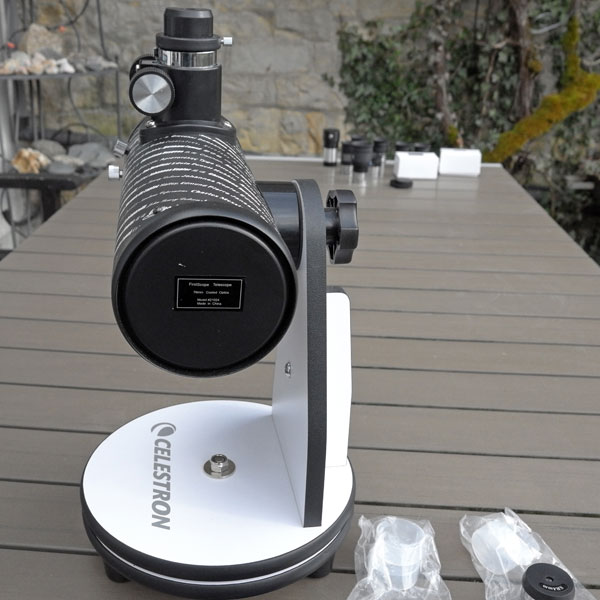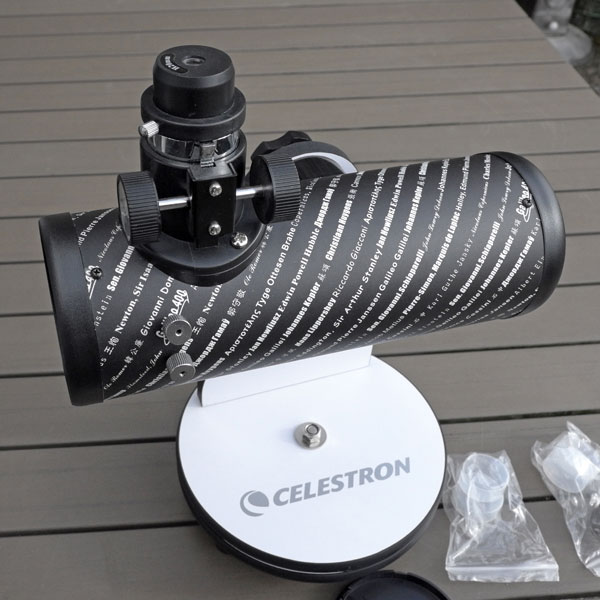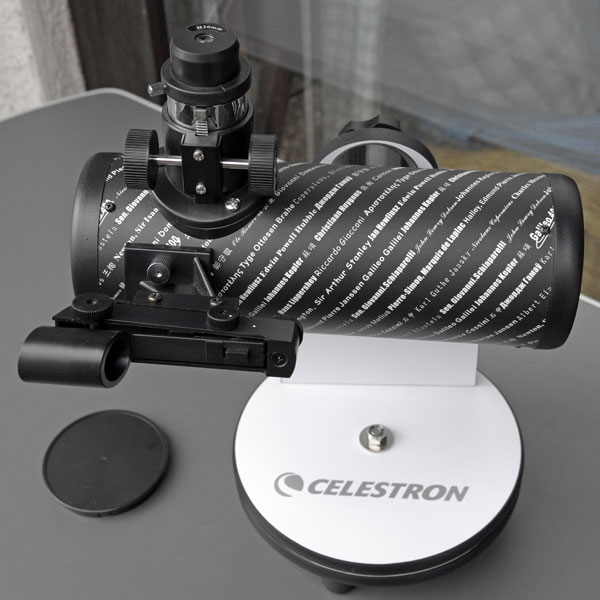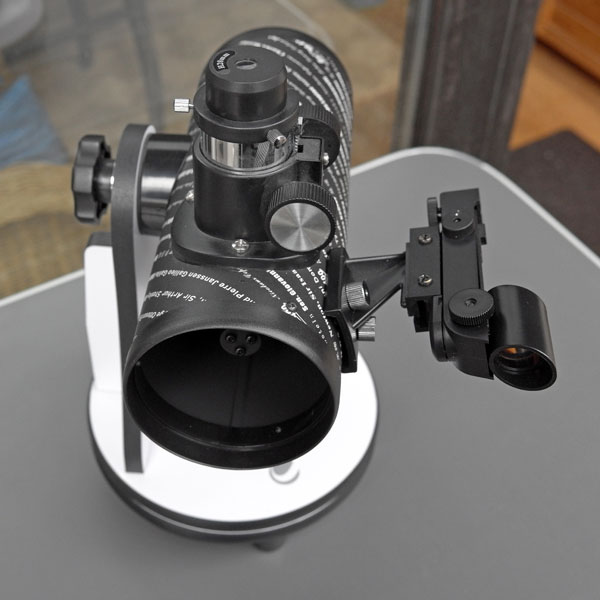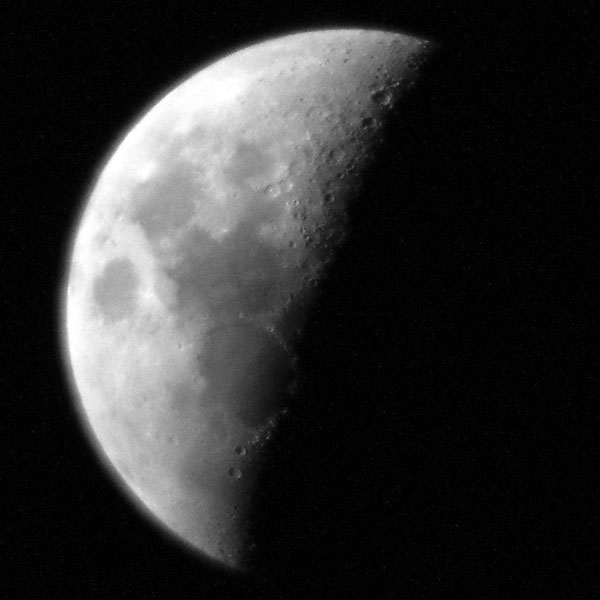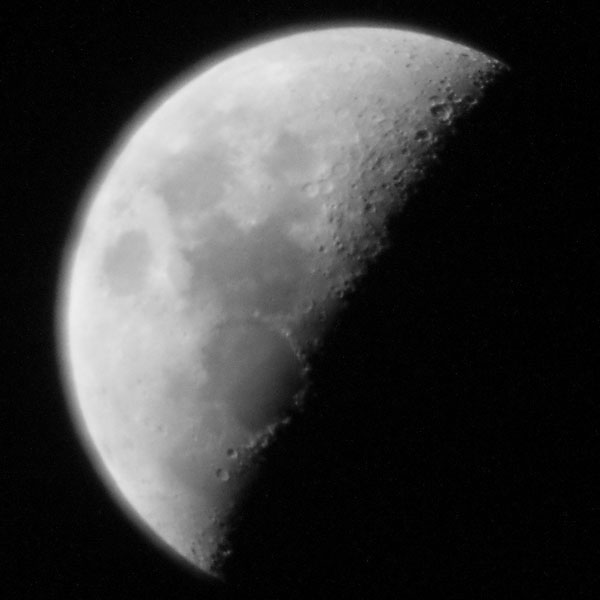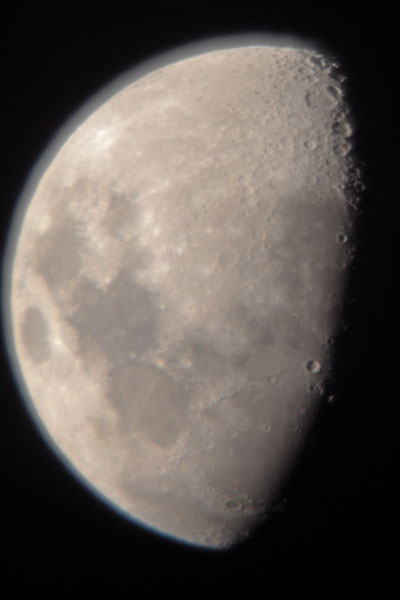Sky-Watcher Heritage 76 Information (3" Dobson)
Motivation | Look | Photo Attempts | Conclusions | Supplement: Observations with the Celestron FirstScope 76 (End of February/Mid-March 2017) | Links | Appendix: Data
Archive
On this page, I present some information about my smallest travel telescope (Dobson)*, a Sky-Watcher Dobson Telescope Heritage N 760/300, or Heritage 76 for short (purchased at the end of January, 2014). See the appendix for the data.
Note that this telescope is very similar to the Celestron FirstScope 76 or even identical to it (see photos). However, the FirstScope is delivered with different eypieces (4 mm and 20 mm instead of 10 mm and 25 mm) and without finderscope (there is an accessory kit available). The Orion FunScope 76, which is delivered with a 20 mm and a 10 mm eyepiece as well as an LED red-dot finder, is also more or less identical to the FirstScope. By the way, I soon bought a red-dot finder for my Heritage 76 as well, because I found it more useful than the finder scope that was supplied with it.
| *Note: I gave the telescope away in March 2016 (see below). I therefore can no longer report any experiences with this scope here. |
Note: In February / March 2017, I had the opportunity to borrow and test a Celestron FirstScope 76. See below for my impressions.
Motivation
Why did I buy the Sky-Watcher Heritage 76 telescope and for what purpose? At Christmas 2013, my friend had received a Celestron FirstScope 76 as a present from his children, and I liked its look so much that I wanted to buy something similar for our travels, because my Heritage P130 seemed too big and heavy for this purpose. However, I finally did not buy the Celestron scope, but an identical Sky-Watcher Heritage 76. This was supplied with better and better graded eyepieces, but only with a spherical primary mirror, which seems to be the case at least with newer Celestron versions as well.
My experiences with the Heritage 76 telescope were rather disappointing (see Conclusions), even after several attempts to adjust the telescope. My friend's Celestron telescope seems to provide a much better image quality. Finally, in July 2015, after a year and a half, I decided to purchase the slightly larger Heritage 100P with a parabolic main mirror and see how it performed compared to the Heritage 76. The Heritage 100P was unfortunately a lot bigger and heavier than the Heritage 76, but so much better with respect to its image quality that I "retired" the Heritage 76 and gave it away in March 2016.
Look
Unpacking and Assembling
|
Outer package |
Outer package and package of the Heritage 76 Outer Package: Package: |
Package of the Heritage 76 |
|
Ditto |
Opened package |
Ditto |
|
Content of package |
Ditto |
Telescope assembled |
|
Ditto |
View into the telescope |
Accessories: 10mm and 25mm eyepieces; finderscope |
Comparison with Heritage P130
Celestron FirstScope 76
At the end of February 2017, I had the opportunity of borrowing the Celestron FirstScope 76 from a friend and test it at home. Here are some photos of the telescope. For my impressions, see below.
|
FirstScope 76 seen from the side |
Seen from the other side |
Front view |
|
Look into the telescope tube; at the front there is the secondary mirror, at the back the primary mirror |
Lid opened, 20 mm eyepiece used |
Ditto, rear view |
|
Rear view with technical data |
Rear view |
Telescope seen from the front and above |
|
Ditto, other side; red dot finder added |
Ditto, seen from the back and above |
Ditto, seen from the front and above |
| Acessories: 4 mm und 20 mm eyepieces (Huygens/Ramsden type); red dot finder added from my supply | ||
Photo Attempts
All these examples are not good enough for offering larger size versions (1200 pixels)...
Here is another example from July 2015 after I had collimated the telescope (Leica X Vario held to the eyepiece):
This photo may look a little bit sharper than the previous ones (particularly the larger version), but there is still the light glow at the left edge of the moon.
All in all, I am not satisfied with the photo results that this telescope produces.
Conclusions
My experiences with the Heritage 76 Telescope were rather disappointing. Planets were superimposed by interfering disturbances and were barely recognizable in their details - the not much larger Heritage 100P is much better in this respect. This was also true, albeit to a lesser extent, after I had tried to adjust the telescope. Perhaps, the spherical mirror is the cause of the poor results, or my copy was not OK (which I doubt).
Compared with the Heritage P130 particularly liked the light weight, the telescope is a real "lightweight", the smaller size (for transport) and the simple-to-use mounting (the telescope is not as top heavy as the P130 and does not have to be tightened again and again). Compared with the 100P, it is smaller and lighter again, which is good for transportation. On the other hand, the Heritage 76 is naturally limited by its small aperture and small focal length (and thus, low magnification) and thus, inferior to all my other telescopes. Whether the spherical mirror is the reason for the lower image quality compared with my other scopes, is unclear to me...
2014, and again after the adjustment at the end of July 2015, I made test photos of the moon (1:50 method = camera held close to the eyepiece). In general, my moon photos were not as sharp as those taken with my other telescopes - often, there was a glimmer on the edges of the moon. Similar effects are likely to have washed out details in other areas. After adjusting the scope, the sharpness seemed, however, to have improved somewhat.
Note: Considering these experiences, I decided in favor of the newly acquired Heritage 100P and gave the telescope away in March 2016 - I do not need two small telescopes... Therefore, I regrettably cannot report any further experiences with this telescope here.
Supplement: Observations with the Celestron FirstScope 76 (End of February/Mid-March 2017)
At the end of February 2017, I had the chance to borrow a Celestron FirstScope 76 to, on the one hand, compare it with my new Sky-Watcher Infinity 76 telescope for kids (in the Omegon version) because they both have similar specifications, and, on the other hand, to check once again, whether this identically constructed telescope does not exhibit the weaknesses of my Heritage 76 that I gave away. The latter one can, of course, not be properly checked if you no longer have both telescopes at your disposal. But, at least, I wanted to see whether I would be content with the results of the Celestron FirstScope 76 (e.g. when used as a travel telescope).
First of all, however, I have to ask why Celestron delivers this telescope with two Huygens / Ramsden eyepieces, which definitely deliver "tunnel vision". If the telescope is not supplied with a finder, it is even harder to locate objects using such eyepieces than with the eyepieces that Sky-Watcher provides (the 10 mm eyepiece is probably of a Kellner type, the 25 mm eyepiece could even be a Plössl) and which are accumulating at my home over the years... Even the Sky-Watcher eyepieces do not get a good rating on the Internet, but they have, at least, a larger field of view than the Celestron ones. But why can Sky-Watcher and its associated companies (Celestron, Orion) not deliver their telescopes at least with simple Plössl eyepieces? The price is hardly likely to rise immensely for such a step...
Daylight Observations
I tested the Celestron FirstScope 76 with its own eyepieces (20 mm and 4 mm Huygens / Ramsden), those from Sky-Watcher (25 mm Plössl?, and 10 mm Kellner), and some Plössl eyepieces from my Revelation eyepiece case (20, 15, 12 and 9 mm) tried (I now use the case with other eyepieces...). Finally, due to the lack of a corresponding short focal length Plössl eyepiece, I tested my 6 mm HR planetary eyepiece with an approx. 70 ° angle of view at the telescope.
The first ting that you realize when using the Celestron eyepieces is their "tunnel view." Due to the higher magnification, view through the 4 mm eyepiece is also quite "dark" and lacks contrast (exit pupil about 1 mm). At the center, both eyepieces deliver a sharp image, at the edges much less. Both eyepieces also show some color fringing, which did not bother me, though. At night the last two weaknesses probably do not matter much (for visual observation).
When you compare the eyepieces directly, the two Sky-Watcher eyepieces stand out by their larger angles of view, the image looks brighter, but they also magnify less than the Celestron eyepieces. Of course, the 10 mm Sky-Watcher eyepiece cannot be compared with the 4 mm Celestron eyepiece, but a Barlow lens might be used to come close in magnification. The Barlow lenses that I own (Sky-Watcher, Revelation), however, are both of bad to moderate quality (the Revelation is slightly better). Thanks to such experiences, I am not fond of Barlow lenses...
However, when I compare the 20 mm Plössl eyepiece with the 20 mm Celestron eyepiece, the image appears much brighter and clearer in the first, thus also more rich in contrast. Compared with the 25 er Sky-Watcher, it also performs better. This inexpensive Plössl eyepiece clearly provides the best quality of the three eyepieces tested and appealing views.
Comparison in Detail
20/25/20 mm Focal length:
- Celestron 20 mm: somewhat blurred at the edges depending on how lou look into it, slight color fringing, narrow visual angle (30 degrees?)
- Sky-Watcher 25 mm: brighter image, more color fringing off-center, larger viewing angle (the viewing angle resembles the one of the Plössl, the image frame is almost not visible), slightly out of focus at the edges depending on how you look into the eyepiece
- Revelation Plössl 20 mm: offers the most contrast and the brightest view of all three eyepieces; I do not see color fringing (this also depends on the motif...); the viewing angle is similar to the one of the Sky-Watcher eyepiece; overall the best of the three eyepieces
I skip the "intermediate" sizes (12 mm, 15 mm), because there are no comparative eyepieces, and move on to the short focal lengths:
- Celestron 4 mm: AT the center quite sharp (details of a distant watch were quite good to see), highest magnification, pincushion distortion, small visual angle, quite "dark", color fringing at the edges
- Sky-Watcher 10 mm: some pincushion distortion, larger angle of view than the 4 mm Celestron eyepiece, but less than half the magnification; the image is brighter than that of the Celestron 4mm (but darker than that of the 20 mm eyepiece); even the "better" Barlow lens does not help much...
- Revelation Plössl 9 mm: larger angle of view but slightly more difficult to look through; nearly half the magnification of the Celestron 4 mm eyepiece; the image is brighter (but darker than at 20 mm); even the "better" Barlow lens does not help much, but a little more than for the 10 mm eyepiece from Sky-Watcher... The 12 mm Plössl eyepiece from the Revelation kit offers a slightly better viewing experience with a little less magnification.
- 6 mm HR planetary eyepiece: less magnification than the Celestron 4 mm eyepiece, brighter image (but also a little bit dark...), best reproduction of details of all short focal length eyepieces tested here
- Note: My three UWA eyepieces (16 mm, 7 mm, 4 mm) do not harmonize well with the Celestron FirstScope 76, or do not offer special added value. At 16 mm, large areas at the image edges are out of focus so that the larger field of view of the UWA cannot really be used. At 7 mm, I get a similar performance as with the 6 mm HR planetary eyepiece. At 4 mm, the telescope is somewhat "overwhelmed", and the image becomes "muddy." In a video on the Internet, I found that only simple Huygens / Ramsden eyepieces can be used with this telescope down to a focal length of 4 mm, but not Plössl (and better) eyepieces. The "limit" was 6.5 mm focal length, but my 6mm HR planetary eyepiece still works well on the Celestron FirstScope 76.
Nocturnal Observations
Daylight observations do not tell too much about what you can expect in the night. First of all, it is, of course, difficult at night as well to find sky objects with the supplied eyepieces, especially if you do not have a viewfinder. To avoid frustration, I therefore "borrowed" the red-dot finder from my Heritage 100P for the observations.
Overview:
- Venus (crescent), Moon (near full and crescent)
- Orion nebula M 42/43, Pleyades (M 45), Hyades (Mel 25), M 35, Andromeda galaxy (M 31), Perseus double star cluster (NGC 884/869)
Venus
My first nightly target was Venus, and I also compared the view with the one in the Heritage 100P and the "similar" Heritage Infinity 76. All three small telescopes showed the Venus crescent, but mostly it appeared doubly or even more often. This is probably due the fact that they all have problems with their mirrors (in the Heritage P130 and in the GSD 680, the Venus crescent did not appear doubly) ... The Venus was bright enough to be seen in the "dark" 4 mm eyepiece (with some color fringing) . Since planets are small anyway, the small field of view of the Celestron eyepieces did not cause any problem for me. Even with the 20 mm eyepiece, the crescent was still detectable, but this was already a bit difficult... And later (almost mid-March), I could even see the Venus crescent with the 32 mm eyepiece (and the 10 x 20 binoculars). This may be due to the fact that the apparent diameter of the Venus greatly increased during this time.
On March 11, 2017, I took some photos with the Celestron 76 of the Venus crescent, the best of which are shown below:
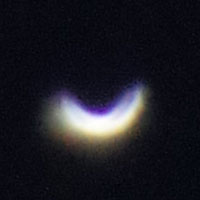 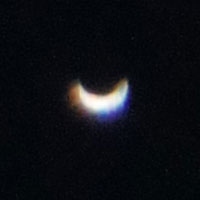 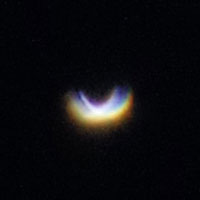 |
On March 13, 2017, I made another attempt at the Venus crescent with the Celestron 76 using eyepieces with focal lengths between 6 mm and 32 mm. Here is a selection of my photos:
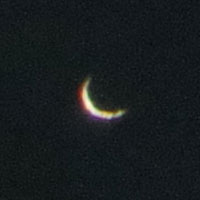 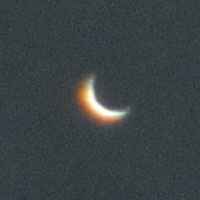 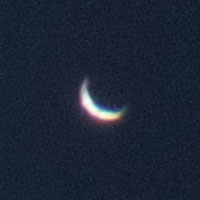 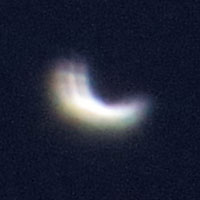 |
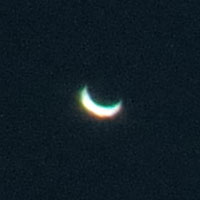 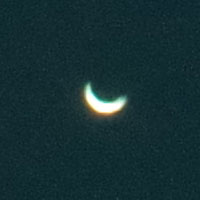 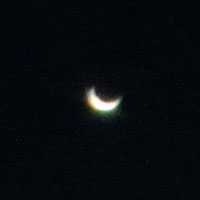 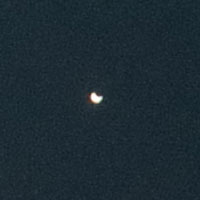 |
Top left: this comes closest to what I saw; top right: 6 mm eyepiece, some shake; bottom right: 32 mm eyepiece, about 9 x magnification! The other photos were taken with focal lengths in between
Orion Nebula (M 42/43)
The Orion Nebula M 42 could also be observed well with the Celestron 76, but OK, this is the largest nebula in the sky... I tried different eyepieces and got the best results with my 6 mm HR planetary eyepiece (I did not use my UWA eyepieces). This corresponds to a magnification of 50 x - almost too much for the Orion Nebula. With eyepieces of a focal length of 10 to 20 mm, larger sky sections can be observed, and the image is also brighter, which is favorable for nebulae.
I was not able to resolve the trapezium (star cluster) in the Orion Nebula in my first attempt, but I succeeded in the second one. I achieved this with a 15 mm and a 12 mm Plössl eyepiece, but, of course, also with shorter eyepieces, such as the 6 mm HR planetary eyepiece, my 4 mm UWA eyepiece, and also with the 4 mm Celestron eyepiece. For the latter I needed some "good will", though...
Pleyades (M 45) and Hyades (Mel 25)
These large open star clusters are, of course, also easy to observe with the "wide-field / rich-field" Celestron 76 telescope. Here, the 20 mm eyepiece was in order (or the 25 mm from Sky-Watcher). My 20 mm-Plössl from the Revelation eyepiece set offered a somewhat brighter and clearer view than both other eyepieces.
M 35
M 35 in Gemini was very high up in the sky so that I had trouble to aim the red-dot finder appropriately. I finally found a kind of star cluster in the eyepiece, but I am not certain that I really found M 35...
Andromeda Galaxy (M 31)
On March 13, 2017, I observed the Andromeda galaxy, but it was very faint in the West. The sky was still too bright at that time of the day...
Perseus Double Cluster (NGC 884/869)
On March 13, 2017, I was also able to find the Perseus double cluster NGC 884/869, although it was not that impressive...
Crescent Moon
On February 28, 2017, the crescent moon appeared in the sky for some time, and, of course, also in the Celestron FirstScope 76. It was so slim that I could barely see craters...
Moon Photos
On March 9, 2017, the moon showed already more than three quarters, and I took some photos of the moon using the projection method (Ricoh GR held at the eyepiece, distance set to infinity, 1600 ASA, EV -3...-4). Here are some results, which might have been a little sharper... But they do not show the glow that the Sky-Watcher Heritage 76 produced:
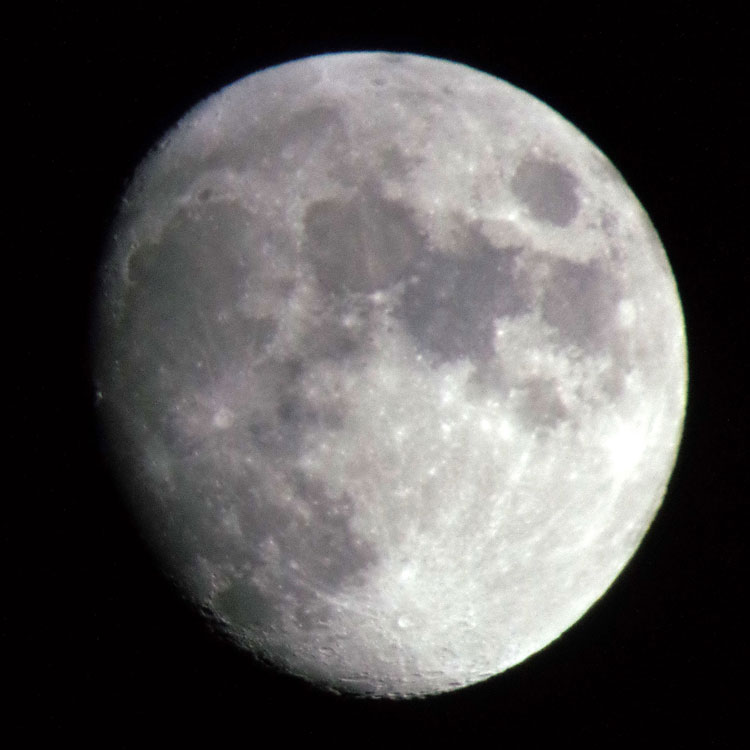 |
 |
|
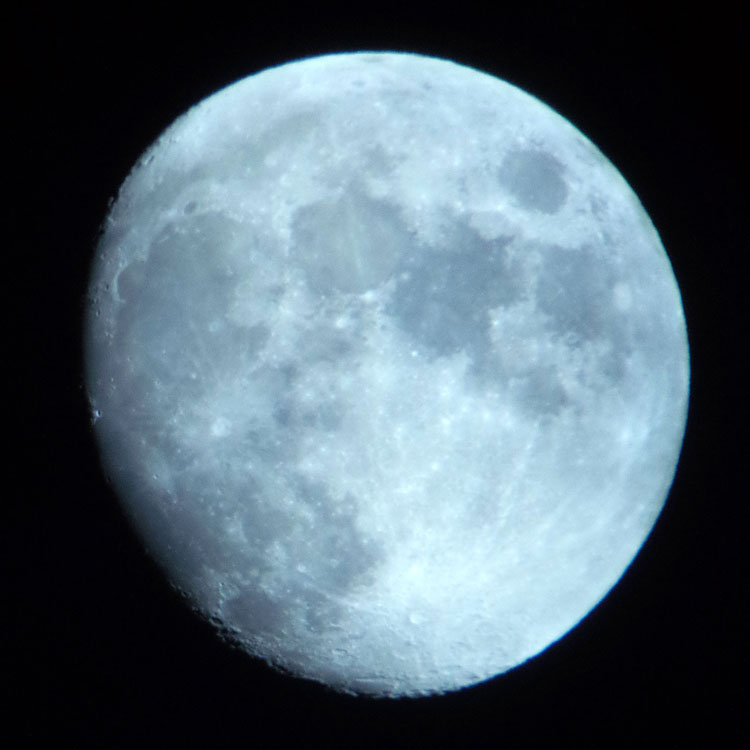 |
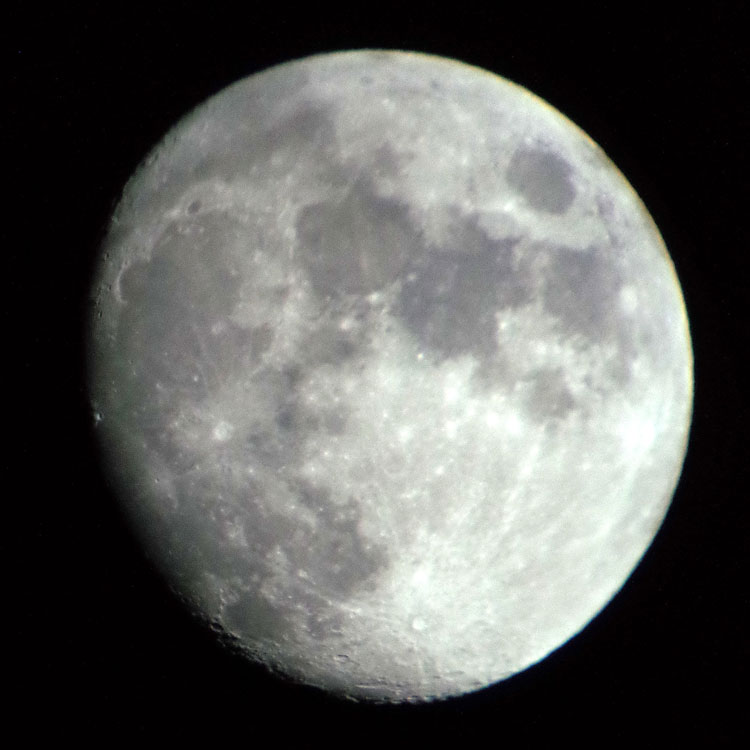 |
The white balance failed for the photo in the bottom left corner, but this photo seems to have the best overall sharpness.
Conclusion
I have not yet tried other deep sky objects, but overall I think that the Celestron FirstScope 76 can almost keep up with my Sky-Watcher Heritage 100P.
Links
- Sky-Watcher Company Website, USA: skywatcher.com
Heritage 76 page on Sky-Watcher Website: www.skywatchertelescope.net/product.php?cat=6&id=56, ca.skywatcher.com/_english/01_products/02_detail.php?sid=362 - Pages from German Distributors
for the Sky-Watcher Heritage 76
(in German)
- Astroshop (here I bought the telescope): www.astroshop.de/skywatcher-dobson-teleskop-n-76-300-heritage-dob/p,23896#tab_bar_3_select
- Teleskop-Service: www.teleskop-express.de/shop/product_info.php/language/de/info/p2926_Skywatcher-Heritage-76-300mm-Mini-Dobsonian.html (in German) - www.teleskop-express.de/shop/product_info.php/language/en/info/p2926_Skywatcher-Heritage-76-300mm-Mini-Dobsonian.html (in English)
- Diskussion "Skywatcher Heritage 76/300 MiniDob": forum.astronomie.de/phpapps/ubbthreads/ubbthreads.php/topics/951643/Skywatcher_Heritage_76_300_Min (in German)
- Telescope Reviews UK: Sky Watcher Heritage 76 (Ralph Bell): telescopereviewsuk.wordpress.com/2009/10/28/sky-watcher-heritage-76
- See also my page offering Astronomy Links.
Appendix: Data for Sky-Watcher Dobson Telescope Heritage 76
| Telescope: Sky-Watcher | Heritage 76 |
| Optical Design | Newton (Spherical) |
| Primary Mirror Diameter | 76 mm (3") |
| Focal Length, Focal Ratio | 300 mm, f/3.95 |
| Resolving Power (arc secs) | 1.51" |
| Limiting Visual Stellar Magnitude | 11.2 mag |
| Light Gathering Power | 117.9 |
| Maximum Practical Visual Power | ca. 100 x (152 x) |
| Optical Tube Dimensions (diam. x length) | n.a. |
| Net Weight Basis | n.a. |
| Net Weight Optical Tube | n.a. |
| Net Weight Complete | 1.75 kg |
Dark Blue: Telescopes that I still own; italic and dark red: telescopes that I owned; black: for comparison; *) own measurement; corrected values
See also the table of basic data for all of my telescopes (and a few more...)
| 30.12.2019 |
